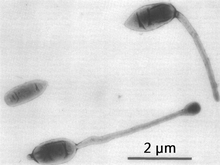ヒフォミクロビウム属
表示
| ヒフォミクロビウム属 | ||||||||||||||||||
|---|---|---|---|---|---|---|---|---|---|---|---|---|---|---|---|---|---|---|
 3個のHyphomicrobium sp.の細胞。
2個は、母菌糸の残骸であろう突起を持つ。 | ||||||||||||||||||
| 分類 | ||||||||||||||||||
| ||||||||||||||||||
| 学名 | ||||||||||||||||||
| Hyphomicrobium Stutzer & Hartleb 1899[1] (IJSEMリストに記載 1980[2]) | ||||||||||||||||||
| タイプ種 | ||||||||||||||||||
| ヒフォミクロビウム・ブルガレ Hyphomicrobium vulgare Stutzer and Hartleb 1899[1] (IJSEMリストに記載 1980[2]) | ||||||||||||||||||
| 下位分類(種) | ||||||||||||||||||
|
ヒフォミクロビウム属(ハイフォミクロビウム属)はグラム陰性の非芽胞形成偏性好気性桿菌。細胞周期の一部で鞭毛を有する。ヒフォミクロビウム科に属し、その基準属である。基準種はヒフォミクロビウム・ブルガエ。GC含量は59から65。
海水、淡水及び土壌に広く見いだされる。脱窒を行う通性メタン酸化細菌でメタノールやホルマリン、ギ酸などの存在下でよく増殖するが、炭素数の多い化合物はうまく利用できない。特徴的な細胞分裂を行うことで知られ、出芽細菌と称される。細胞分裂を行う際、母細胞が菌糸を伸ばし、その先端に芽ができると母細胞からDNAが送られ、芽に隔壁出来てさらに鞭毛が作られ娘細胞が分離する。鞭毛は娘細胞の成長とともに失われる。この分裂形式は近縁のロドミクロビウム属やペドミクロビウム属でもみられる。
脚注
[編集]- ^ a b c Stutzer A, Hartleb R (1899). “Untersuchungen über die bei der Bildung von Salpeter beobachteten Mikroorganismen”. Mitteilungen des Landwirtschaftlichen Institutes der Kaiserlichen Universitat Breslau 1: 75-100.
- ^ a b c V. B. D. Skerman, Vicki. McGOWAN, P. H. A. Sneath (01 January 1980). “Approved Lists of Bacterial Names”. International Journal of Systematic and Evolutionary Microbiology 30 (1): 225-420. doi:10.1099/00207713-30-1-225.
- ^ a b c d e Hirsch P. (1989). “Genus Hyphomicrobium Stutzer and Hartleb 1898, 76AL”. In Staley JT, Bryant MP, Pfennig N, Holt JG. Bergey's manual of systematic bacteriology, vol. 3.. The Williams & Wilkins Co.(Baltimore). pp. 1895-1904.
- ^ a b c d e “Validation of the Publication of New Names and New Combinations Previously Effectively Published Outside the IJSB”. International Journal of Systematic and Evolutionary Microbiology 39 (4): 495-497. (01 October 1989). doi:10.1099/00207713-39-4-495.
- ^ I R McDonald, N V Doronina, Y A Trotsenko, C McAnulla, J C Murrell (01 January 2001). “Hyphomicrobium chloromethanicum sp. nov. and Methylobacterium chloromethanicum sp. nov., chloromethane-utilizing bacteria isolated from a polluted environment.”. International Journal of Systematic and Evolutionary Microbiology 51 (1): 119-122. doi:10.1099/00207713-51-1-119. PMID 11211248.
- ^ “Notification that new names and new combinations have appeared in volume 51, part 1, of the IJSEM”. International Journal of Systematic and Evolutionary Microbiology 51 (2). (01 March 2001). doi:10.1099/00207713-51-2-269.
- ^ TEIZI URAKAMI, JUNKO SASAKI, KEN-ICHIRO SUZUKI, KAZUO KOMAGATA (01 July 1995). “Characterization and Description of Hyphomicrobium denitrificans sp. nov.”. International Journal of Systematic and Evolutionary Microbiology 45 (3): 528-532. doi:10.1099/00207713-45-3-528.
- ^ “Notification that New Names and New Combinations Have Appeared in Volume 45, No. 3, of the IJSB”. International Journal of Systematic and Evolutionary Microbiology 45 (4): 881. (01 October 1995). doi:10.1099/00207713-45-4-881.
- ^ Izumi Y, Takizawa M, Tani Y, Yamada H. (1982). “An obligate methylotrophic Hyphomicrobium strain, identification, growth characteristics and cell composition”. Journal of Fermentation Technology 60: 371-375.
- ^ “Validation of the Publication of New Names and New Combinations Previously Effectively Published Outside the IJSB: List No. 10”. International Journal of Systematic and Evolutionary Microbiology 33 (2): 438-440. (01 April 1983). doi:10.1099/00207713-33-2-438.
- ^ Christine Martineau, Céline Villeneuve, Florian Mauffrey, Richard Villemur (01 October 2013). “Hyphomicrobium nitrativorans sp. nov., isolated from the biofilm of a methanol-fed denitrification system treating seawater at the Montreal Biodome”. International Journal of Systematic and Evolutionary Microbiology 63 (Pt_10): 3777-3781. doi:10.1099/ijs.0.048124-0. PMID 23667138.
- ^ Aharon Oren, George M. Garrity (01 January 2014). “Notification that new names of prokaryotes, new combinations and new taxonomic opinions have appeared in volume 63, part 10, of the IJSEM”. International Journal of Systematic and Evolutionary Microbiology 64 (Pt_1): 6-7. doi:10.1099/ijs.0.059436-0.
- ^ Elena Borodina, Donovan P. Kelly, Peter Schumann, Frederick A. Rainey, Naomi L. Ward-Rainey & Ann P. Wood (04 December 2001). “Enzymes of dimethylsulfone metabolism and the phylogenetic characterization of the facultative methylotrophs Arthrobacter sulfonivorans sp. nov., Arthrobacter methylotrophus sp. nov., and Hyphomicrobium sulfonivorans sp. nov.”. Archives of Microbiology 177: 173–183. doi:10.1007/s00203-001-0373-3. PMID 11807567.
- ^ “Validation of publication of new names and new combinations previously effectively published outside the IJSEM. International Journal of Systematic and Evolutionary Microbiology”. International Journal of Systematic and Evolutionary Microbiology 52 (3): 685-690. (01 May 2002). doi:10.1099/00207713-52-3-685.
- ^ Qing Xu, Yuxiao Zhang, Xing Wang & Gejiao Wang (28 October 2021). “Hyphomicrobium album sp. nov., isolated from mountain soil and emended description of genus Hyphomicrobium”. Archives of Microbiology 203: 5931–5936. doi:10.1007/s00203-021-02473-6. PMID 34709419.
参考文献
[編集]- Brock 『微生物学』 (2003年)
- 発行研究所 『IFO 微生物学概論』 (2010年)
